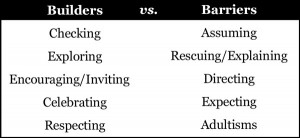I love the story in the Bible, in John 5, of the man who lay helplessly by the pool of Bethesda. The story goes that angels came and stirred the water, and whoever got into the pool first received miraculous healing. People flocked from near and far for a chance to be healed.
There was a man who had been sick for thirty-eight years and couldn’t make it to the pool fast enough. “When Jesus saw him lying there and knew that he had already been there a long time, he said to him, “Do you want to be healed?”
What an insensitive question, Jesus! What do you think, certainly this man wants to be healed!
Can we stop and consider for a moment that we are to a great extent the authors of our own experience in life. We tend to repeat patterns of perception and behavior over and over without really realizing that there are other options open to us.
You know the old story of the woman who was asked why she always cut off the end of the ham before she put it in a pot. She answered that she really did not know why but her mother had taught her to cook a ham in that way. When she asked her mother and finally her grandmother the grandmother said that the pan that she had was not big enough for the whole ham. Often practices that start for very practical reasons continue far beyond their reason for being.
How often do we continue to follow the same patterns of behavior without having any particular reason for doing things in the way that we are doing them? It is my contention that the man at the pool of Bethesda knew how to sit on his mat at the edge of the pool but to do something different was somehow a larger challenge than he was willing to accept.
We can complain that life is not going the way we want it to go. If we want change we must be willing to experiment with doing things differently. I had a friend who decided he wanted to quit smoking. He threw away a whole carton of cigarettes. That is the spirit of willing.
There is a book on addiction that I have not read but the title says it all. The title of the book is “I will quit tomorrow”. Tomorrow never really comes. Change only happens in the present. The present is the only thing that is real. New life happens the way it did for the disciples of Jesus. They dropped their nets and followed Him. This is the structure of New Life. It happens NOW.





